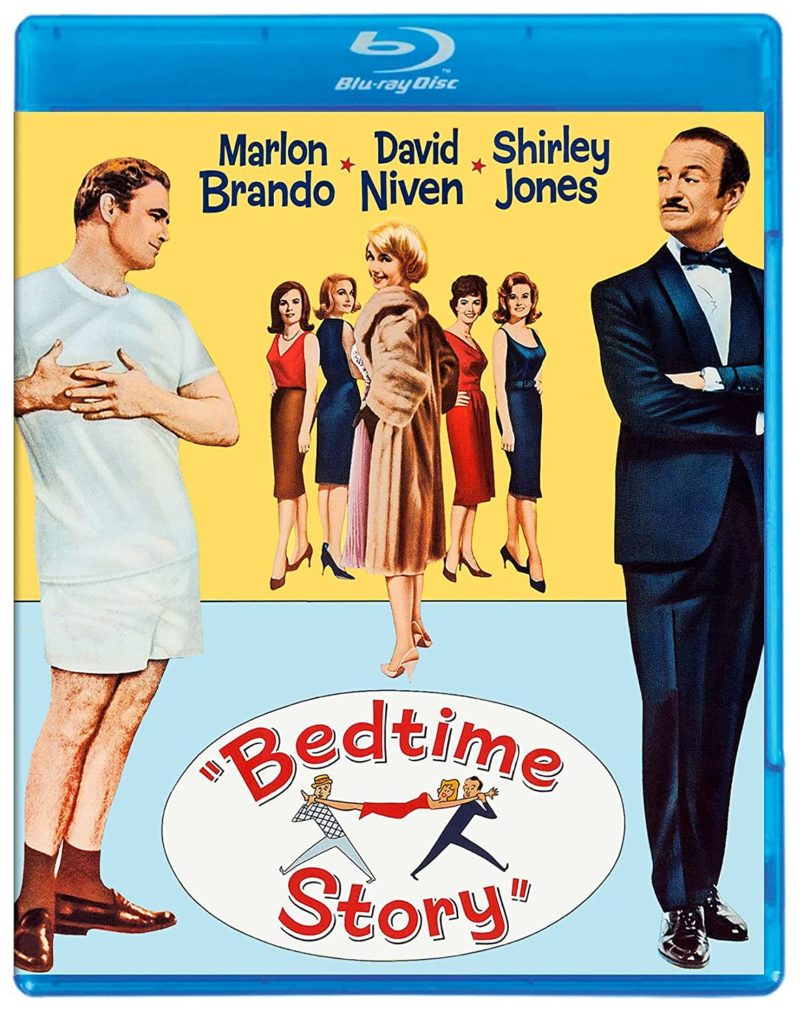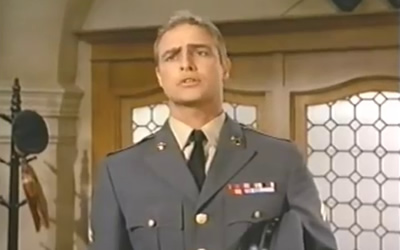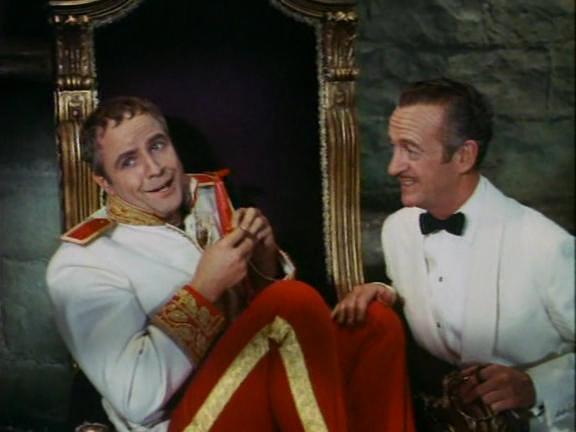Brando And Niven Play The Dirtiest, Rottenest Of Scoundrels
DIRECTED BY: RALPH LEVY/1964
BLU-RAY STREET DATE: DECEMBER 14, 2021

For easy reference, Marlon Brando is playing what would be Steve Martin’s role in this story’s most popular reiteration, Dirty Rotten Scoundrels (1988), while David Niven originates the Michael Caine role. And if you know that film, you know the gist: dapper Lawrence (Niven) is the top con artist on the French Riviera, seducing rich women in order to steal their jewels; Freddy (Brando) is the uncouth upstart who horns in on the easy bounty. Their instant rivalry, and temporary partnership, are the meat of the movie. While many of the story beats line up from iteration to iteration, there’s a deep and disturbing, fundamentally cruel spirit to Bedtime Story that the newer version supplants with a more audience-pleasing engine of “fun” and, with Martin’s presence, an expectation of zany shenanigans, all of which, while successfully entertaining, obscures the ugly underneath of their clearly chauvinistic goals. Surprisingly, it’s the older version that’s not afraid to roast these much dirtier, much more rotten scoundrels.
For those who’ve seen and enjoyed the ’88 version, the most surface pleasure of watching Bedtime Story is in the checking off of obvious similarities between the two, but to stop there is to miss the wholesale deconstruction of a certain kind of charmingly caddish man-on-the-make that’ve populated movies since the beginning of cinema. In fact, both actors in this film made their mint portraying versions of the dominating male in search of his catch to the point that anyone walking into this film in 1964 might have a reasonable expectation of the same – only to find, if their radar was up, a devastating and wholly deserved comeuppance for the type, made sweeter by the fact that the film’s two writers, Paul Henning and (especially) Stanley Shapiro, had already written standard men-will-be-men scripts previous to this.

Further, many of the funnier moments – most obviously the sequence wherein Freddy assumes a fake disability to garner sympathy from the main mark (a game Shirley Jones) – aren’t just excuses to draw laughs, as they are in the remake. Instead, they play against the expectations of films from the era, where Freudian implications tend to be treated with utmost exploratory respect. Yet here, Freddy’s demonstration of debilitating mental anguish seems extra transgressive, as Brando is essentially doing a (truly funny) send-up of his very first film role, the wheelchair-bound soldier in Fred Zinnemann’s serious-minded psychological drama The Men (1950). Watching Brando having his feet slapped hard with a stick, but for laughs not pathos, is funny in and of itself, but more so for the deep reservoir of highly-charged psychological gravitas we know must be churning in that Kazan-addled imagination of his. And here is where the writers and director Ralph Levy are smart: they know that any audience watching Brando knows he’s thinking more deeply than he’s letting on, and it’s that very identification that allows the audience to feel okay with the pain he’s receiving for the terrible things he’s doing to the women in the film. For us to truly feel he’s getting his due punishment, it’s not enough that he just be a conniving charlatan who gets found out, he must be a cinematically mid-century conscience getting slapped silly with a stick.

For her part, Shirley Jones (as “soap queen” Janet Walker) is the unsung hero of the movie for her thankless position as innocent bystander, a pivot point around which the misogynistic gamesmanship turns. But in a premise that requires all of the targeted women to be somewhat gullible, if not outright dumb, Jones gets us on her side with her innate intelligence and an overwhelming sense of genuine compassion for Freddy – and a reasonable trust in Lawrence, who she believes is a brilliant psychologist – such that any assumptions we have that she might just be an insipid lonelyheart are cast against the colorful locales.
In any case, the movie never really wants us to follow Janet as a central character anyway – she’s merely the mark… Any blooming romance here is intended for Lawrence and Freddy. This is ultimately the perverse love story of two con artists whose constant one-upping of each other is closer to unabashed courtship than outright detestation. When the two become exactly aware that they are two of a kind, there’s almost no difference in the underlying tone of mutual respect, AKA love, as the thieves-cute in Trouble in Paradise (1932). The difference there is that the elegant Parisian locales of Miriam Hopkins and Herbert Marshall’s tag-team larceny are actually absorbed into their personas, which are then reflected back into the movie, with Lubitsch’s fabled “touch” elevating the entire affair into a kind of fantasy. Here, the sparkling Riviera can only ever be a beautiful backdrop that further highlights just how grotesque the two men’s schtupping libidos are.

It might be too much to say there’s an overt homoerotic component to the movie, but there are signs that it was at least teased. Case in point, the dual shots of Lawrence sculpting busts in his studio: the first is during a bit of expositional dialogue with Andre (Aram Stephan), his aide-de-camp in female wrangling, while also sculpting the face of a female model standing across the room. During this, we see Lawrence idly crafting something the camera almost doesn’t want us to notice – it’s a breast, which, in a movement that highlights his otherworldly misogyny, he smash-presses into place with all the artistic inquiry of Dreyfuss’s living room mountain. Then later, although it’s revealed to be part of a ruse he’s concocting to best him, he’s delicately carving a quite perfect bust of Freddy with only the image that he’s apparently burned deeply into his imagination. It takes a rarefied intent to recall the particularities of a subject’s face enough to recreate it on the pedestal, and here he does it with a kind of casual glee that is only sinister on the surface – one wonders how far Lawrence might be willing to take the mandate “know thy enemy”…
Kino Lorber Studio Classics’ Blu-ray shows off the gorgeous locales of Cannes…when it’s Cannes… but more so impresses by making us believe it’s all the Riviera when the bulk of it is the Universal lot. To that truth, we learn a lot about cinematographer Clifford Stine, and many other production points of interest, from commentary by stalwart film historians Howard S. Berger and Nathaniel Thompson, whose typical brand of friendly conversation informs a deep well of personal, perhaps life-long familiarity with the film – and seemingly any film at all related to it in any way. It’s always a pleasure to find a movie that you can enjoy, and then be affirmed in the goodness of that film by others so richly devoted to it. Berger and Thompson always make the listener feel a bit cooler than they felt going in, and certainly more knowledgable.
All in all, the film is a study in contrasts that wears its lasciviousness as a badge. But more deeply, it’s a kind of treatise on the maleness represented in so many other films that take that maleness at face value. And in so many ways, it works as a forward-reaching wrist slap to its too-happily-oblivious remake – the 60s correcting the 80s in one satirical swipe.
The images in this review are not representative of the actual Blu-ray’s image quality, and are included only to represent the film itself.

